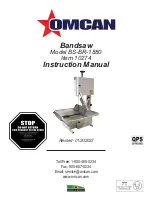
8
Palmgren Operating Manual & Parts List
83118
OPERATION (CONTINUED)
TYPE OF CUT
•
Rip fence guides workpiece to produce straight cuts on longer
pieces.
•
Contour cutting is done by guiding workpiece free-handed to
produce curved shapes.
•
Beveled cutting can be done by tilting table and using proper
work guide method.
•
Regardless of which work guiding method is used, a workpiece
which overhangs table by more than 7” should be properly
supported by support stands. See Recommended Accessories,
page 13.
RIP FENCE OPERATION
Refer to Figures 10 and 11.
•
Rip fence can be used to guide boards with one square edge
past blade when table is aligned properly.
•
Set rip fence to desired width of cut on inside of throat.
Remember to include the thickness of material that will be
removed by blade.
•
Use a square to measure from tip of a tooth to fence. Lock
fence securely with knob (Figure 10, Ref. No. 6).
•
The portion of material between blade and fence is considered
the workpiece. Material on outside and behind cut is the scrap
material which is being cut off. Use the right hand to keep work
against fence.
•
Do not push on scrap portion of the work. This could pinch or
bind blade.
•
Avoid passing hands beyond the cut. Use push sticks or push
blocks to finish cuts and pass workpiece away from blade.
•
A storage bracket (Figure 11, Ref. No. 21) for rip fence is located
on the rear of saw.
CONTOUR SAWING
•
When contour sawing, use both hands to keep workpiece flat
against table and guided along desired path.
•
Avoid positioning hands in line with blade. If hands slip they
could contact blade.
•
Try to stand to front of the saw and use hands over the portion
of table which is to right of blade and before cut.
•
Cut small corners by sawing around them. Saw to remove scrap
until desired shape is obtained.
BEVEL CUTTING
Refer to Figure 10.
•
Perform a bevel operation by tilting table. Loosen knob (Ref.
No. 11) and tilt table to desired position.
•
Use a square or protractor to set angle and lock table in posi-
tion with knob. Use caution when supporting work while bevel
cutting. Do not allow work to hang on blade.
MITER GAUGE
Refer to Figure 10.
•
Use miter gauge for securing and holding workpiece at desired
angle to produce angled cuts. Use scale to adjust gauge to
desired angle.
•
Never use miter gauge and rip fence at the same time. The
blade might bind in the workpiece. Operator could be injured
and/or workpiece could be damaged.
•
A storage bracket (Ref. No. 33 is located on the rear of saw.
BLADE CLEANING BRUSH
Refer to Figure 8.
•
Make sure that brush (Ref. No. 36) is in contact with blade to
properly remove foreign particles from drive wheel.
CHIP BLOWER
Refer to Figure 11, page 18.
Band saw is equipped with chip blower used to remove chips to
make contour cutting easier.
Adjust air nozzle (Ref. No. 45) so that pump air blows chips away
from blade and workpiece.
MAINTENANCE
WARNING:
Make certain that unit is disconnected from power
source before attempting to service or remove any component.
CLEANING
•
Keep machine and workshop clean. Do not allow sawdust to
accumulate on band saw.
•
Keep wheels clean. Debris on wheels will cause poor tracking
and blade slippage.
•
Keep mechanisms and threaded or sliding surfaces clean and
free of foreign particles.
•
Operate band saw with a dust collector to minimize clean up.
LUBRICATION
•
The shielded ball bearings are permanently lubricated and
require no further lubrication.
•
Small amounts of machine oil can be applied to belt tension
mechanisms and threaded or sliding surfaces.
•
Occasionally apply a coat of paste wax to table top to keep it
slick and corrosion free.
KEEP BAND SAW IN REPAIR
•
If power cord is worn or cut in any way, have it replaced.
•
Replace V-belt and blade when they are worn. Replace any
damaged or missing part.
•
Use parts list to order parts.









































